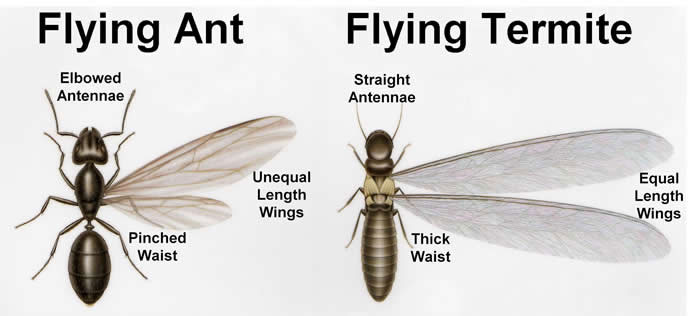There are four species of termite which inhabit Missouri, and they are all subterranean, which means they inhabit soil or wood that is in close contact with soil. Subterranean termites are extremely destructive to wood structures. They consume wood constantly, day in and day out, around the clock. In nature, they are considered beneficial insects as they help break down wood and release it’s nutrients back into the soil. In an urban setting, they can cause serious harm to a structure and given enough time, they can collapse it entirely. It’s been estimated that termites cause roughly $4.5 BILLION dollars worth of damage to homes in the United States every year. Termite eradication requires specialized knowledge. If you suspect a termite infestation, it’s very important that you contact a pest control specialist with the necessary training in termite control. The damage adds up quickly.
There are three distinct types of termite, the worker, the soldier and the reproductive class, which is made up of a queen, a king and alates, aka swarmers. Many people don’t realize they have a termite infestation until they see a swarm of alates on their property in late spring and early autumn, and even then they sometimes mistake them for winged ants. Swarmers are winged termites that mate after taking off from their home colony in hopes of starting a new one. Swarmers shed their wings after mating and you will often find them laying on the ground in great quantities after a swarm. The illustration above clearly shows the difference between flying termites and flying ants.
Workers have cream-colored bodies and are very tiny, a ¼ inch or shorter in length, with squarish heads. The Soldier termite has huge, intimidating jaws that help them fight off intruders and defend the nest. Termites are social insects and live in huge colonies that average between 50,000 up to several hundred thousand individuals.
How to check for termites
Termites don’t always leave evidence, but there are signs that you can look for if you suspect an infestation.
- Check around your house (especially around the foundation) for ‘mud tubes’. Termites construct these tubes so that they can move around without exposure to outside elements.
- Look for soft, brittle or darkened wood that makes a hollow sound when you tap it.
- Termites will leave small piles of very fine, very soft sawdust around an area where they are consuming, digesting and excreting wood. It is much finer and softer than normal sawdust.
- Look for shed wings around windowsills or close to doors.
- If you find any of these symptoms, it’s imperative that you contact a pest control company immediately if you want to preserve the value of your home.
Why choose Setgo?
We have experience managing termite infestations at every stage of development and in every setting, from historical sites to pre-construction. We provide effective, affordable and GUARANTEED termite extermination. We offer very fairly priced pre-sale inspections for local realtors.

